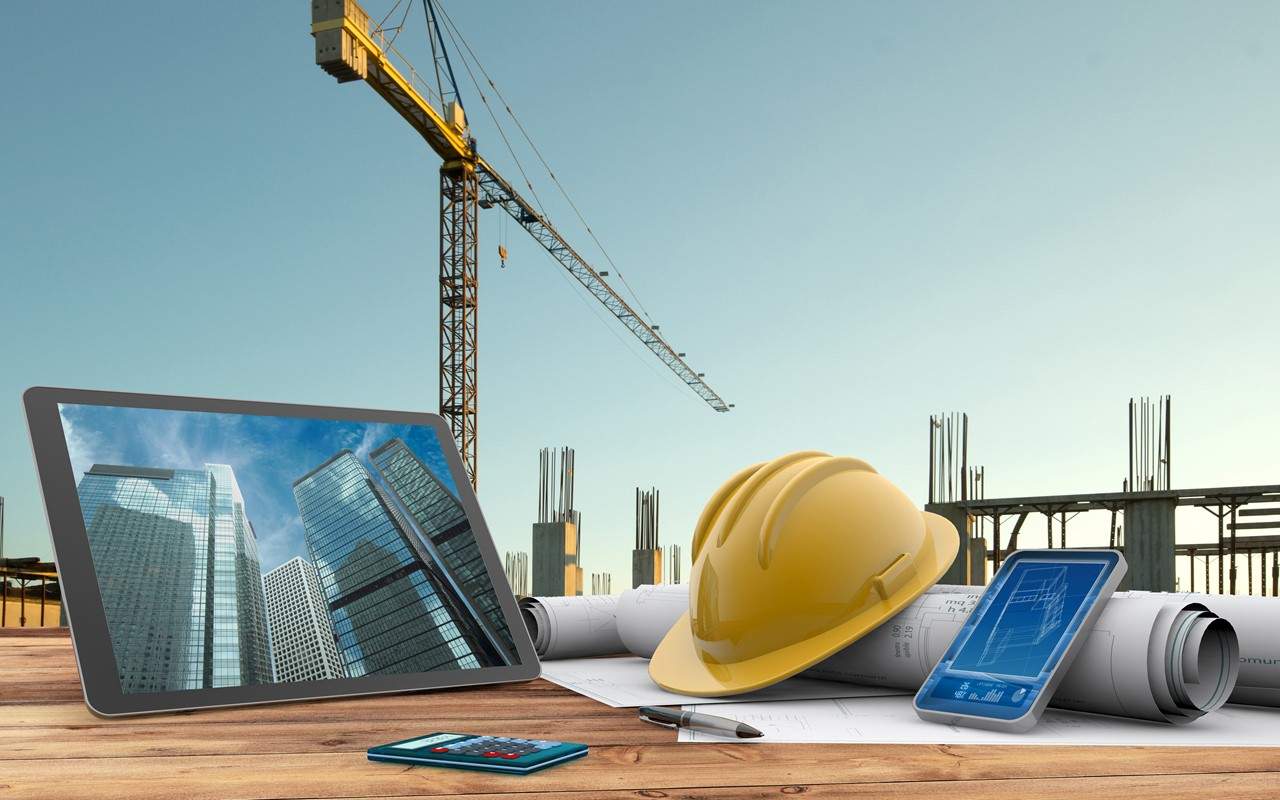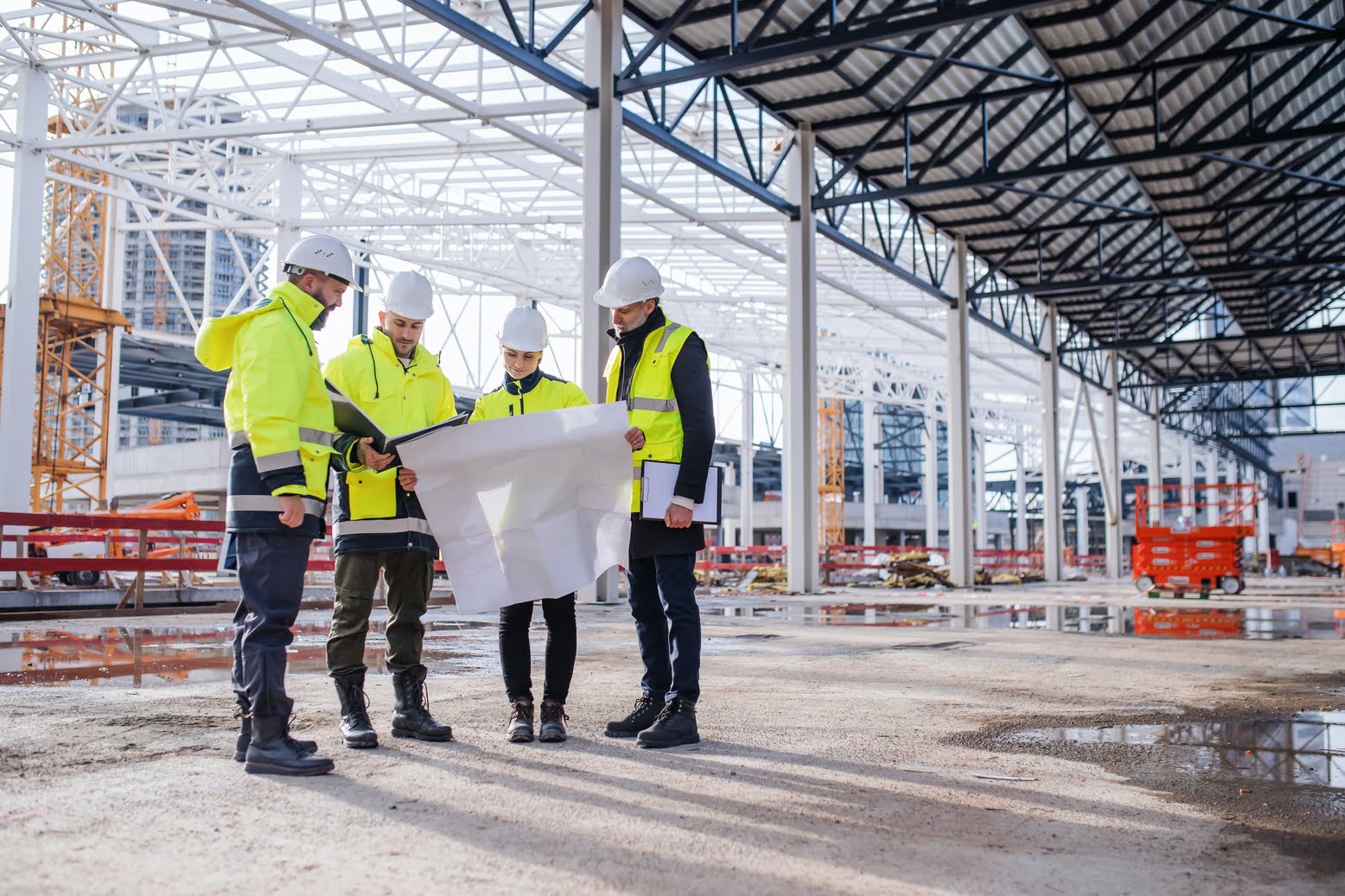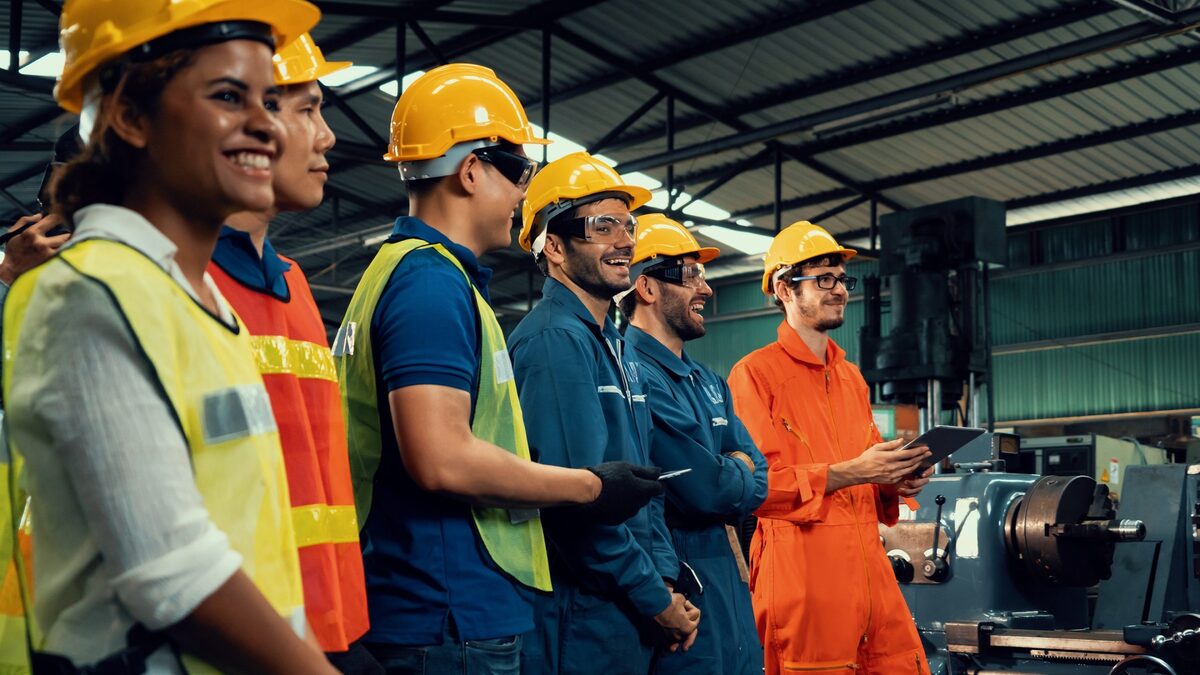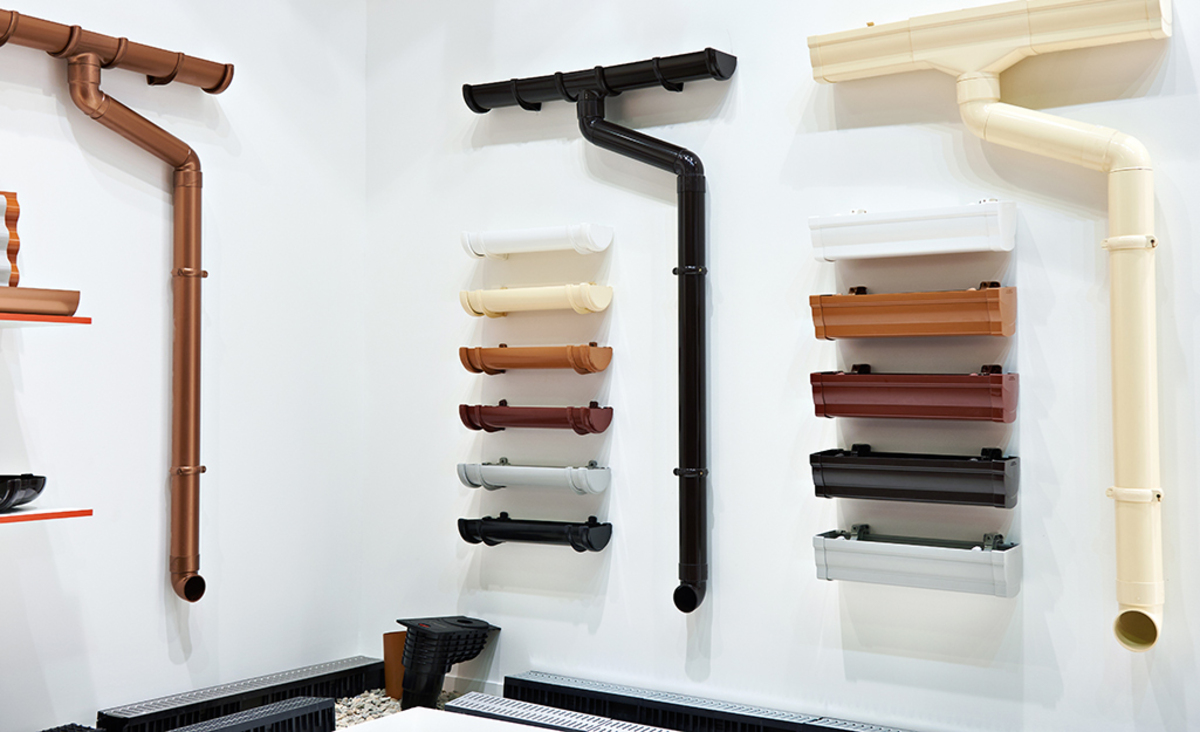Home>diy>Building & Construction>What Are The Different Technologies In Construction?


Building & Construction
What Are The Different Technologies In Construction?
Modified: January 9, 2024
Discover the various technologies in building construction and how they are revolutionizing the industry. From green building practices to advanced construction materials, stay informed and ahead in the field.
(Many of the links in this article redirect to a specific reviewed product. Your purchase of these products through affiliate links helps to generate commission for Storables.com, at no extra cost. Learn more)
Introduction
When it comes to the construction industry, technology has significantly transformed the way we design, plan, and build structures. From 3D printing to virtual reality, a wide range of innovative technologies have emerged to enhance efficiency, productivity, and safety in the construction process. In this article, we will explore some of the different technologies in construction and how they are revolutionizing the industry.
One of the most exciting advancements in construction technology is 3D printing. This cutting-edge technique allows for the creation of complex and intricate structures by layering materials in a precise and controlled manner. 3D printing not only speeds up the construction process but also reduces material waste. This technology has the potential to revolutionize the industry by enabling the construction of sustainable, cost-effective, and customized buildings.
Another game-changing technology is Building Information Modeling (BIM). BIM is a digital representation of a building, incorporating all its physical and functional characteristics. It allows architects, engineers, and contractors to collaborate effectively and visualize the entire project before construction even begins. With BIM, stakeholders can identify and resolve potential clashes or errors, resulting in a more streamlined and efficient construction process.
Virtual Reality (VR) and Augmented Reality (AR) are rapidly gaining popularity in the construction industry. VR immerses users in a virtual environment, allowing them to experience and interact with a building or space before it is built. AR overlays digital content onto the real world, providing real-time information and instructions onsite. Both technologies enhance visualization, communication, and decision-making, reducing errors and enhancing safety on construction sites.
Drones are another innovative technology that is changing the construction landscape. These unmanned aerial vehicles can capture high-resolution images, collect data, and create 3D models of construction sites. Drones enable surveyors and project managers to quickly and accurately assess terrain, measure distances, and monitor progress. This data-driven approach improves project planning, saves time, and enhances safety on construction sites.
Robotics is another technology that is transforming the construction industry. From autonomous bricklaying robots to robotic exoskeletons for workers, these machines are enhancing productivity and safety on construction sites. Robots can perform repetitive or hazardous tasks with precision and consistency, reducing the risk of accidents and improving overall efficiency.
In response to growing environmental concerns, green building technologies have gained significant traction in recent years. These technologies focus on sustainable and energy-efficient building practices. They include features such as solar panels, smart energy management systems, water recycling systems, and green roofs. Implementing green building technologies not only reduces the environmental impact of construction but also results in long-term cost savings for building owners.
Prefabrication and modular construction have also emerged as popular construction methods. Prefabrication involves manufacturing building components in a controlled factory environment and then assembling them onsite. Modular construction takes this a step further by creating entire volumetric modules that can be easily transported and assembled. These methods offer faster construction timelines, reduced waste, and improved quality control.
The Internet of Things (IoT) is revolutionizing the construction industry by connecting various devices and systems. IoT enables real-time monitoring and data collection, allowing for predictive maintenance, improved resource management, and enhanced safety. From monitoring equipment performance to tracking worker location and safety, IoT has the potential to transform construction sites and operations.
Autonomous construction equipment is another emerging technology trend in the industry. These autonomous machines can perform tasks such as excavation, grading, and material handling without a human operator. By utilizing advanced technologies such as GPS, sensors, and artificial intelligence, autonomous equipment improves efficiency, reduces labor costs, and enhances safety on construction sites.
As the construction industry continues to evolve, it is crucial for professionals to embrace and adapt to these new technologies. By harnessing the power of 3D printing, virtual reality, drones, robotics, green building technologies, IoT, and autonomous equipment, construction companies can enhance productivity, efficiency, and sustainability, ultimately shaping a smarter and more advanced built environment.
Key Takeaways:
- Embrace the Future: From 3D printing to IoT, construction technologies are revolutionizing the industry, enhancing efficiency, safety, and sustainability. Embracing these innovations is crucial for shaping a smarter and more advanced built environment.
- Efficiency and Safety: Autonomous equipment, drones, and green building technologies are transforming construction, improving productivity, safety, and environmental impact. Embracing these technologies is key to a more efficient and sustainable construction industry.
3D Printing in Construction
One of the most groundbreaking technologies in the construction industry is 3D printing. Also known as additive manufacturing, 3D printing involves the creation of three-dimensional objects by layering materials based on a digital model. While 3D printing has gained popularity in various sectors, its application in construction is revolutionizing the way buildings are designed and constructed.
Traditionally, construction involved the assembly of materials such as concrete, steel, and wood. However, with 3D printing, layers of building materials are deposited precisely and gradually to create complex structures. This automated process allows for greater design freedom and customization. Architects and engineers can now create intricate and unique shapes that would be difficult or time-consuming to achieve using traditional construction methods.
One of the major advantages of 3D printing in construction is its potential to reduce material waste. By precisely depositing materials layer by layer, 3D printing minimizes the amount of raw materials needed for construction. This not only leads to cost savings but also promotes sustainability by reducing environmental impact. Additionally, 3D printing enables the use of recycled and eco-friendly materials, further enhancing its environmental benefits.
Another significant benefit of 3D printing in construction is its speed. Traditional construction methods often require time-consuming processes such as formwork, curing, and drying. With 3D printing, buildings can be constructed in a fraction of the time. The automated process eliminates the need for manual labor in many aspects of construction, allowing for faster completion of projects.
Furthermore, 3D printing allows for on-site construction, reducing transportation costs and logistical challenges. Large-scale printers can be transported to the construction site, enabling the creation of structures directly on location. This is particularly advantageous for remote or hard-to-access areas where traditional construction methods may not be feasible.
3D printing also offers improved quality control in construction. Computer-aided design (CAD) models are converted into precise instructions for the 3D printer, ensuring accurate and consistent results. This reduces the risk of human error and inconsistencies that can arise with traditional construction methods. Moreover, 3D printing allows for real-time monitoring and adjustments, enabling immediate corrections during the construction process.
While 3D printing in construction is still a relatively new technology, its potential is immense. As the technology continues to advance and become more widely adopted, we can expect to see increased integration of 3D printing in construction projects. From customizable and sustainable homes to intricate and complex architectural structures, 3D printing is transforming the way we build, offering greater efficiency, customization, and sustainability in the construction industry.
Building Information Modeling (BIM)
Building Information Modeling (BIM) is a digital representation of a building or infrastructure project that incorporates all its physical and functional characteristics. BIM allows architects, engineers, and contractors to collaborate seamlessly and visualize the entire project from design to construction and maintenance. It has revolutionized the construction industry by improving communication, reducing errors, and enhancing efficiency throughout the project lifecycle.
One of the key advantages of BIM is its ability to enable effective collaboration among project stakeholders. Unlike traditional 2D drawings or physical models, BIM provides a centralized platform where architects, engineers, and contractors can work together in real-time. This shared digital environment facilitates better coordination and communication, leading to improved project outcomes.
With BIM, stakeholders can visualize the building in 3D and explore different design options before construction even begins. They can identify clashes or conflicts between different systems, such as mechanical, electrical, or plumbing, and resolve them in the planning stages. This early detection of design issues helps in reducing costly rework and delays that may occur during construction.
Furthermore, BIM enables accurate quantity takeoffs and cost estimations by linking the digital model with cost data. This feature allows for better cost control and budgeting throughout the project. Contractors can generate material schedules and extract quantities directly from the BIM model, ensuring more precise and efficient procurement processes.
During the construction phase, BIM can be utilized to improve project coordination and sequencing. The model can be broken down into construction sequencing steps, providing a clear roadmap for contractors and sub-contractors. This ensures that all parties involved are aware of the construction schedule and can plan their activities accordingly, minimizing conflicts and delays on the construction site.
Moreover, BIM enhances the operation and maintenance of buildings. The digital model can be enriched with information about individual building components, such as equipment specifications, maintenance schedules, and warranty information. This data can be accessed by facility managers to streamline maintenance operations and plan for future renovations or upgrades.
Another significant benefit of BIM is its compatibility with other technologies such as virtual reality (VR) and augmented reality (AR). The BIM model can be used to create immersive virtual reality experiences, allowing stakeholders to visualize the building in a more interactive and realistic way. On-site, AR can overlay digital information onto the physical building, providing real-time guidance and instructions to construction teams.
As the construction industry continues to embrace digital transformation, BIM has become a fundamental tool for effective project management and decision-making. Its ability to streamline collaboration, enhance visualization, improve cost control, and optimize construction sequencing has made it an indispensable technology in the construction industry. By leveraging the power of BIM, construction companies can improve project outcomes, reduce risks, and deliver high-quality buildings that meet client expectations.
Virtual Reality (VR) and Augmented Reality (AR) in Construction
Virtual Reality (VR) and Augmented Reality (AR) are rapidly transforming the construction industry, offering new possibilities for design visualization, collaboration, and on-site construction. These immersive technologies allow project stakeholders to experience and interact with the built environment in innovative and engaging ways.
VR creates a completely digital environment that users can explore and interact with using specialized headsets. In the context of construction, VR allows architects, engineers, and clients to visualize buildings and spaces before they are constructed. This immersive experience provides a deeper understanding of the design, enabling stakeholders to make informed decisions and identify potential issues early on.
AR, on the other hand, overlays digital content onto the real world, enhancing the physical environment with virtual elements. In construction, AR can be used to provide real-time information and guidance directly at the construction site. For example, by wearing AR-enabled goggles, workers can see digital overlays that show them the precise locations for installations or provide step-by-step instructions for complex tasks.
One of the primary benefits of VR and AR in construction is improved design communication and collaboration. With VR, project stakeholders can walk through a virtual building, experiencing its spatial dimensions and visualizing design concepts more effectively than traditional 2D drawings. This immersive experience fosters better collaboration, as stakeholders can provide real-time feedback, make design changes, and resolve issues collectively.
AR provides a valuable tool for on-site construction. By overlaying digital models or instructions onto the physical environment, AR helps workers visualize how components fit together or where specific installations need to be made. This technology streamlines construction processes and reduces errors, as workers can refer to digital information directly in their field of view, minimizing the need for manual measurements or interpretations.
VR and AR also play a crucial role in enhancing safety on construction sites. VR can be used to simulate hazardous scenarios or emergency situations, allowing workers to practice safety protocols in a controlled virtual environment. AR, on the other hand, provides real-time guidance and warnings, highlighting potential hazards or obstacles on the construction site. By improving situational awareness, VR and AR technologies contribute to reducing accidents and promoting a safer working environment.
From a client perspective, VR and AR can greatly enhance the pre-construction experience. Clients can immerse themselves in a virtual representation of their future building, experiencing the look and feel of different design options. This allows for better decision-making and ensures that the final product meets their expectations. Additionally, AR can be used to provide interactive presentations or walkthroughs during project reviews, enabling clients to have a more hands-on understanding of the design and construction progress.
As VR and AR technologies continue to evolve and become more accessible, their integration into the construction industry is expected to grow significantly. The use of VR and AR in construction brings numerous benefits, including improved design communication, enhanced collaboration, increased safety, and enriched client experiences. By leveraging these immersive technologies, construction professionals can optimize their workflows, streamline processes, and deliver projects that meet the highest standards of quality and innovation.
Drones in Construction
Drones, also known as unmanned aerial vehicles (UAVs), have become a game-changer in the construction industry. These flying devices equipped with cameras and sensors are revolutionizing the way construction sites are surveyed, monitored, and managed. Drones offer numerous benefits that improve efficiency, accuracy, and safety in construction projects.
One of the primary applications of drones in construction is aerial surveying and mapping. Drones can capture high-resolution images and create detailed topographic maps of construction sites with remarkable speed and accuracy. This data can be transformed into 3D models, allowing project stakeholders to visualize the terrain and plan accordingly. Compared to traditional surveying methods, which can be time-consuming and costly, drones significantly reduce the time and resources required for surveying.
In addition to surveying, drones provide valuable data for site inspections and progress monitoring. By regularly flying over construction sites, drones can capture images and videos that enable thorough inspections of structures, preventing potential issues or defects. Construction managers can use this data to monitor the progress of the project, ensuring that it is on schedule and meeting quality standards. Drones also help identify discrepancies between the actual construction and the architectural plans, enabling timely adjustments and reducing rework.
With their ability to access hard-to-reach or dangerous areas, drones enhance safety in construction. Rather than sending workers to heights or confined spaces, drones can perform visual inspections of structures, identifying potential safety hazards without putting human lives at risk. This minimizes the need for workers to operate in hazardous environments and reduces the likelihood of accidents. Drones also play a vital role in site security, allowing construction companies to monitor the premises and prevent unauthorized access.
Besides photography and surveillance, drones can also be used for transporting lightweight materials within construction sites. This aerial delivery system eliminates the need for manual transport, increasing efficiency and reducing labor costs. Drones can transport tools, equipment, and even small components to the required locations, saving time and streamlining operations on-site.
Another advantage of drones in construction is their ability to improve project communication and collaboration. By utilizing real-time data and images captured by drones, project stakeholders can have a shared understanding of the site conditions and progress. Architects, engineers, and contractors can make informed decisions and address any issues promptly, leading to improved collaboration and more effective project management.
As the technology continues to advance, drones are being equipped with advanced sensors and technologies such as LiDAR (Light Detection and Ranging), thermal imaging, and aerial 3D scanning. These capabilities provide even more detailed and accurate data for construction projects, enabling better planning, design, and analysis.
It is important to note that the use of drones in construction must adhere to local regulations and guidelines. Construction companies must ensure compliance with airspace regulations, privacy laws, and safety precautions. Hiring licensed and experienced drone operators or training existing staff to operate drones safely and effectively is crucial for maximizing the benefits of this technology.
All in all, drones have become an indispensable tool in the construction industry. Their versatility, efficiency, and safety benefits make them an invaluable asset for surveys, inspections, progress monitoring, and material transportation. By harnessing the power of drones, construction companies can enhance productivity, accuracy, and safety, contributing to more successful and cost-effective construction projects.
When considering different technologies in construction, it’s important to stay updated on the latest advancements such as Building Information Modeling (BIM), 3D printing, and drone technology to improve efficiency and productivity on the job site.
Robotics in Construction
Robotics has emerged as a transformative technology in the construction industry, offering the potential to automate various tasks and improve productivity. Robots in construction can perform repetitive or physically demanding tasks with precision and accuracy, reducing the reliance on manual labor and enhancing safety on construction sites. The integration of robotics in construction is revolutionizing the industry and enabling new possibilities for building construction and maintenance.
One of the key areas where robotics is making a significant impact is in bricklaying. Bricklaying robots can autonomously lay bricks, mortar, and even cut and shape bricks to fit irregular patterns. These robots work collaboratively with human laborers, significantly increasing construction speed and accuracy. By automating bricklaying tasks, construction companies can complete projects faster, with fewer errors and a reduced need for manual labor.
Another application of robotics in construction is 3D printing. Robotic arms or gantries can be programmed to precisely deposit layers of material, such as concrete or other building components, to create structures. 3D printing robots have the potential to revolutionize construction by enabling the fabrication of complex and customized building designs. This technology offers greater flexibility, speed, and cost savings compared to traditional construction methods.
Robotic exoskeletons are another area of robotics innovation in construction. These wearable devices assist workers in carrying heavy loads and performing physically strenuous tasks. Exoskeletons reduce the risk of musculoskeletal injuries, fatigue, and strain, thereby enhancing worker safety and productivity. Construction workers can work for longer durations and with reduced physical exertion, improving efficiency and reducing the likelihood of accidents.
Robotics also plays a crucial role in logistics and material handling on construction sites. Autonomous robots or drones can be deployed to transport materials, tools, or equipment within construction sites. These robots navigate through the site using sensors, cameras, or GPS systems, ensuring efficient and timely delivery of materials. By automating material handling tasks, construction companies can optimize resource allocation, minimize delays, and improve overall project efficiency.
Furthermore, robotic surveying and scanning systems enable accurate site measurements and data collection. These robots can be equipped with LiDAR (Light Detection and Ranging) or other sensors to create precise 3D models of existing structures or terrain. This data can then be used for planning, design, and quality control purposes. Robotic surveying eliminates the need for manual measurements, reducing the risk of human errors and enabling faster data acquisition.
While robotics offers significant benefits, it is important to note that human workers still play a vital role in the construction industry. Robots are best suited for tasks that are repetitive, hazardous, or physically demanding. Human workers, on the other hand, possess critical thinking, problem-solving, and adaptability skills that are essential for complex construction tasks.
As robotics continues to evolve and become more sophisticated, its integration into construction processes is expected to expand. Construction companies that adopt robotics can realize numerous benefits, including increased efficiency, improved safety, reduced labor costs, and enhanced quality control. The collaboration between humans and robots has the potential to revolutionize the construction industry, making construction sites safer, more productive, and more technologically advanced.
Green Building Technologies
Green building technologies have gained significant traction in the construction industry in recent years. These technologies focus on implementing sustainable and environmentally-friendly practices throughout the design, construction, and operation of buildings. Green buildings aim to reduce their carbon footprint, conserve resources, and improve overall energy efficiency. The adoption of green building technologies offers numerous benefits for both the environment and building occupants.
One of the key aspects of green building technologies is energy efficiency. Buildings account for a significant portion of global energy consumption. Green buildings utilize technologies and strategies to minimize energy consumption, such as advanced insulation, energy-efficient lighting systems, and smart energy management systems. By reducing energy demand, green buildings help conserve natural resources and reduce greenhouse gas emissions.
Renewable energy sources play a vital role in green building technologies. Solar panels are a popular choice for generating clean and sustainable energy. Solar systems can be installed on rooftops or integrated into building facades, harnessing sunlight to generate electricity. Wind turbines and geothermal systems are also utilized in some cases to further enhance the energy efficiency of green buildings.
Water conservation is another crucial aspect of green building technologies. With the increasing scarcity of water resources in many regions, green buildings implement various strategies to reduce water consumption. Low-flow fixtures, such as faucets and toilets, are installed to minimize water usage. Rainwater harvesting systems are also implemented to collect and store rainwater for non-potable uses such as irrigation and toilet flushing.
Green buildings prioritize materials that are environmentally friendly and have a low impact on human health. Sustainable materials, such as recycled or locally sourced materials, are preferred over traditional construction materials. In addition, green buildings aim to reduce waste generation during the construction process by implementing efficient construction practices and recycling materials. These practices reduce the environmental impact, conserve resources, and promote a healthier indoor environment.
Green building technologies also focus on indoor environmental quality. The aim is to create spaces that are comfortable, healthy, and promote well-being for occupants. This includes adequate ventilation systems, natural daylighting, and the use of low-toxicity materials. By prioritizing indoor environmental quality, green buildings provide healthier and more productive spaces for people to live and work in.
Smart building technologies are increasingly integrated into green buildings. These technologies utilize data and automation to optimize building performance, energy usage, and occupant comfort. Smart sensors and systems monitor and control various aspects of the building, such as lighting, temperature, and ventilation, to ensure optimal energy efficiency. This real-time data helps facility managers make informed decisions to improve building performance and reduce operational costs.
Green building technologies also take into account the entire life cycle of a building, from design and construction to operation and maintenance. The concept of life cycle assessment helps evaluate the environmental impact of a building throughout its lifespan. This holistic approach encourages long-term sustainability and ensures that green buildings continue to perform efficiently over time.
The adoption of green building technologies is driven by the desire to create sustainable, healthy, and environmentally-conscious structures. Green buildings not only have a positive impact on the environment but also offer economic benefits, such as reduced utility costs, increased property value, and improved occupant satisfaction. By embracing green building technologies, the construction industry is playing a significant role in addressing global environmental challenges and working towards a more sustainable future.
Prefabrication and Modular Construction
Prefabrication and modular construction methods have emerged as innovative approaches to enhance efficiency and productivity in the construction industry. These methods involve the manufacturing of building components off-site in controlled factory environments, which are then transported and assembled onsite. Prefabrication and modular construction offer numerous benefits, including reduced construction time, improved quality control, and enhanced sustainability.
Prefabrication involves the production of building components, such as walls, floors, and ceilings, in a factory setting. These components are then transported to the construction site for assembly. Prefabrication allows for simultaneous work at the factory and construction site, reducing project timelines significantly. With prefabrication, project schedules can be streamlined, and construction time can be reduced by eliminating many onsite construction activities.
Modular construction takes prefabrication to the next level by creating entire volumetric modules that are complete with interiors, fixtures, and finishes. These modules are manufactured off-site and transported to the construction site, where they are assembled to create the final building structure. Modular construction offers flexibility and customization, as modules can be easily reconfigured or added to accommodate changing project requirements.
One of the primary benefits of prefabrication and modular construction is the significant reduction in construction time. By shifting construction activities to controlled factory environments, weather delays and onsite disruptions are minimized. Building components can be produced simultaneously as other site preparation activities take place, allowing for faster project completion. This reduced construction time leads to cost savings and faster return on investment.
Prefabrication and modular construction also offer improved quality control. In the factory, building components are manufactured under strict quality standards and undergo rigorous inspections. This controlled environment ensures greater precision and consistency in the manufacturing process. As a result, the finished modules or components are of higher quality, with fewer defects and deviations from design specifications.
These construction methods also contribute to sustainability and resource efficiency. Waste reduction is a significant advantage of prefabrication and modular construction. By manufacturing components off-site, materials can be optimized to minimize waste. Additionally, the controlled environment allows for more efficient use of energy, water, and other resources. The focus on sustainability also extends to the choice of environmentally-friendly materials and systems, further reducing the environmental impact of the construction process.
Another advantage of prefabrication and modular construction is the potential for cost savings. The efficiency and speed of these methods result in reduced labor and site management costs. Additionally, the precision in manufacturing significantly reduces the risk of rework, delays, and construction errors often associated with traditional construction practices. These factors combined contribute to overall cost savings for construction projects.
Prefabrication and modular construction also offer improved site safety. With much of the construction taking place off-site, the number of workers required onsite is reduced. This, in turn, minimizes the risk of accidents and injuries. The manufacturing facilities used in prefabrication and modular construction are also equipped with advanced safety measures and protocols, ensuring workers operate in a controlled and safe environment.
However, it is important to note that prefabrication and modular construction require careful planning and coordination. Detailed design and accurate documentation are essential to ensure proper fitting and assembly of the building components. Transport and logistics considerations must also be taken into account to ensure timely delivery and efficient onsite assembly.
Overall, prefabrication and modular construction methods are transforming the construction industry by offering faster, more efficient, and higher quality construction processes. By leveraging these methods, construction companies can achieve cost savings, reduced construction time, improved quality control, and enhanced sustainability. As the demand for faster, more sustainable construction continues to grow, prefabrication and modular construction are becoming increasingly popular choices for a wide range of building projects.
Internet of Things (IoT) in Construction
The Internet of Things (IoT) is revolutionizing the construction industry by connecting various devices and systems to the internet, enabling real-time monitoring, data collection, and analysis. IoT technology is transforming construction sites into smart, interconnected environments that enhance productivity, improve resource management, and enhance safety.
One of the key applications of IoT in construction is real-time monitoring of equipment and machinery. By equipping construction equipment with IoT sensors, data on their performance, utilization, and maintenance needs can be collected and analyzed. This information enables proactive maintenance planning, identifying potential issues before they cause equipment failures or costly downtime. Equipped with IoT sensors, equipment can also be remotely accessed and controlled, streamlining operations and optimizing their utilization.
IoT technology also enables monitoring and optimization of energy usage on construction sites. Smart sensors can be installed in buildings and equipment to collect energy consumption data. This information can be analyzed in real-time to identify areas of inefficiency and implement energy-saving measures. IoT-enabled systems can automatically adjust lighting, temperature, and other energy-consuming devices based on occupancy or specific conditions, reducing energy waste and lowering operational costs.
Furthermore, IoT sensors can be used for monitoring and improving construction site safety. Sensors can detect hazardous situations, such as high levels of dust, toxic gases, or excessive noise. Real-time alerts can be sent to workers or supervisors, enabling quick response and necessary actions. IoT technology can also track the location of workers and equipment, ensuring that safety protocols are followed, and potential hazards are mitigated. By providing valuable data on site conditions, IoT enhances safety measures and reduces accidents on construction sites.
IoT technology enables better resource management and inventory control on construction sites. Sensors can track and monitor the usage and availability of construction materials, tools, and equipment. This real-time data helps in efficient inventory management, enabling just-in-time procurement and reducing waste from overstocking or misplaced items. IoT systems can also automate the ordering process by integrating with suppliers’ systems, ensuring a seamless and efficient supply chain.
IoT technology also facilitates improved data collection and analytics for construction projects. Data from various sources, such as sensors, drones, and wearables, can be collected and integrated into a central platform. This data can then be analyzed to gain valuable insights into project progress, quality control, and overall performance. Real-time analytics enable project managers to make data-driven decisions, identify areas for improvement, and optimize project outcomes.
Integrating IoT in construction processes also enables remote monitoring and collaboration. Project stakeholders can access real-time project data, monitor progress, and collaborate seamlessly from anywhere with an internet connection. This capability enhances communication, streamlines decision-making, and reduces the need for physical presence at the construction site. Remote monitoring and collaboration contribute to improved project efficiency, reduced travel costs, and faster decision-making processes.
Despite the numerous benefits, the integration of IoT in construction does come with challenges. Data security and privacy concerns must be addressed to ensure that sensitive project information is protected. Robust IT infrastructure and reliable connectivity are also essential for the seamless operation of IoT systems on construction sites. Furthermore, collaboration and coordination among project stakeholders are crucial to leverage the full potential of IoT technology and ensure its successful implementation.
All in all, IoT technology is transforming the construction industry by connecting devices, enabling real-time data collection, and enhancing communication among project stakeholders. By leveraging the power of IoT, construction companies can improve productivity, optimize resource management, and ensure safer and more efficient construction sites. As IoT continues to evolve, its potential in construction is boundless, shaping the industry towards a more connected, data-driven, and sustainable future.
Autonomous Construction Equipment
The emergence of autonomous construction equipment has revolutionized the construction industry, introducing advanced technologies that enhance productivity, safety, and efficiency on construction sites. Autonomous machines, powered by artificial intelligence, sensors, and GPS technology, are capable of performing various construction tasks with minimal human intervention. These innovative machines are transforming the way construction projects are planned and executed.
One of the primary advantages of autonomous construction equipment is its ability to improve productivity. These machines can work 24/7 without the need for breaks or shift changes, significantly increasing efficiency. With autonomous excavators, bulldozers, and cranes, tasks such as excavation, grading, and material handling can be performed more quickly and accurately. Autonomous equipment eliminates the risk of human error and fatigue, ensuring precise and consistent outcomes.
Safety is a paramount concern in the construction industry, and autonomous equipment helps reduce the risk of accidents and injuries. With advanced sensors and algorithms, autonomous machines can detect and avoid obstacles, including workers, on construction sites. They can navigate complex, hazardous terrains with precision, minimizing the likelihood of collisions or mishaps. By reducing human exposure to dangerous tasks, autonomous equipment contributes to a safer work environment.
Autonomous construction equipment also offers enhanced data collection and analysis capabilities. Equipped with various sensors and cameras, these machines can collect comprehensive data on the construction site, including dimensions, terrain features, and progress. Real-time data is transmitted and analyzed, allowing project managers to make informed decisions and closely monitor project status. This data-driven approach enhances project planning, task sequencing, and resource allocation, leading to improved project outcomes.
Efficiency is a crucial factor in the construction industry, and autonomous equipment contributes to streamlining construction processes. These machines can follow precise path plans, minimizing unnecessary movements and optimizing routes. This not only saves time but also reduces fuel consumption and operating costs. Autonomous equipment is also adaptive, enabling them to adjust to changing site conditions and weather, ensuring continuous productivity and optimal utilization of resources.
Furthermore, autonomous equipment reduces labor costs by reducing the need for manual labor in certain tasks. While human workers are still essential for specialized skills and tasks that require decision-making, autonomous machines can handle repetitive or physically demanding activities. This allows human workers to focus on more complex and value-added tasks, improving overall workforce efficiency.
The integration of autonomous construction equipment into construction projects requires careful planning and coordination. Site conditions and obstacles need to be properly assessed to ensure safe and effective operation of autonomous machines. Additionally, training and familiarization programs for workers and supervisors are necessary to facilitate the seamless collaboration between humans and machines on construction sites.
The use of autonomous equipment is not limited to large-scale construction projects. It can also be beneficial for smaller projects, renovations, and maintenance work. With the advancements in technology, autonomous machines are becoming more accessible and affordable, enabling a wider range of construction companies to adopt these innovative solutions.
Autonomous construction equipment represents the future of the construction industry. By harnessing the power of AI, sensors, and GPS technology, construction companies can improve productivity, safety, and efficiency on construction sites. The integration of autonomous machines allows for more accurate and precise construction processes, leading to cost savings, faster project delivery, and enhanced overall project outcomes. As the technology continues to evolve, the potential for autonomous construction equipment is vast, propelling the industry towards a more advanced and connected future.
Frequently Asked Questions about What Are The Different Technologies In Construction?
Was this page helpful?
At Storables.com, we guarantee accurate and reliable information. Our content, validated by Expert Board Contributors, is crafted following stringent Editorial Policies. We're committed to providing you with well-researched, expert-backed insights for all your informational needs.














0 thoughts on “What Are The Different Technologies In Construction?”